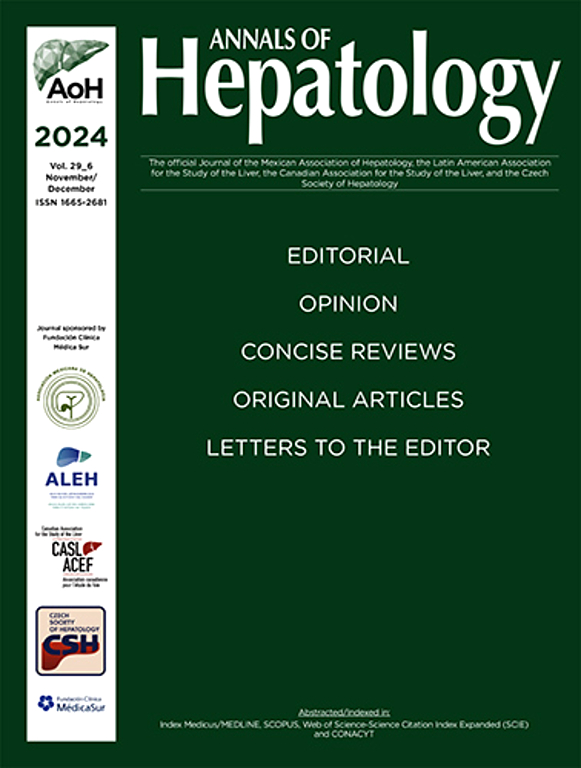Nopal and Pirfenidone Ameliorate Epididymal Fat Weight and Anthropometric Parameters in a Mouse Obesity Model with Diethylnitrosamine
IF 3.7
3区 医学
Q2 GASTROENTEROLOGY & HEPATOLOGY
引用次数: 0
Abstract
Introduction and Objectives
Obesity is associated with liver diseases. Mexico has a high prevalence of obesity and metabolic dysfunction-associated steatotic liver disease (MASLD). Nopal and Pirfenidone (PFD) increase insulin signaling and decrease hepatic steatosis in obese mice. We investigated PFD and nopal on anthropometric parameters in obese mice and with diethylnitrosamine (DEN).
Materials and Methods
Five-six-week-old male C57BL/6J mice were treated with a single dose of DEN (25 mg/kg) and fed with a high fat diet (HFD, 60 kcal% from fat: D12492) for 16 weeks. Animals were provided ad libitum access to food and water. The mice were randomly divided into eight groups (n=5 for each group): normal diet (ND), ND plus DEN (ND+DEN), HFD, HFD plus DEN (HFD+DEN), HFD plus DEN plus supplements (cellulose, maltodextrin, and casein; HFD+DEN+SUPPL), HFD plus DEN plus nopal (HFD+DEN+NOP), HFD plus DEN plus PFD (HFD+DEN+PFD), and HFD plus DEN plus NOP plus PFD (HFD+DEN+NOP+PFD). Freeze-dried nopal in fine powder (7%) were mixed with HFD and PFD (300 mg/kg/day) also were mixed with HFD. PFD dosage was adjusted according to body weight and mixed with the diets three times a week. Food intake was measured three times a week, and measurement of body weight each week. Experiments were done according to ARRIVE guidelines. Statistical significance of anthropometric data was determined for parametric data with one-way ANOVA analysis of variance followed by Tukey's post hoc analysis, statistical analyses were performed using SPSS.
Results
All HFD mice developed obesity (P≤0.05), and PFD and NOP plus PFD reduced body weight (P≤0.05). Liver weight was increased in HFD, HFD+DEN, and HFD+DEN+SUPPL groups (P≤0.05), and epididymal fat was increased in all HFD mice (P≤0.001), but NOP, PFD, and NOP plus PFD reduced liver weight (P≤0.05) and PFD, and NOP plus PFD decreased epididymal fat (P≤0.05). Heart weight was increased in HFD, HFD+DEN, HFD+DEN+SUPPL, and HFD+DEN+NOP groups (P≤0.05), but NOP (p=0.06), PFD, and NOP plus PFD reduced it (P≤0.001). The heart weight/body weight ratio was reduced in all mice with HFD (P≤0.001), and only NOP plus PFD increased the heart weight/body weight ratio (P≤0.05). Liver weight/body weight ratio tended to increase in HFD and HFD plus DEN, but decreased with NOP, PFD, and NOP plus PFD (P≤0.05). Body weight/tibia length ratio was increased in all HFD mice (P≤0.01) and decreased with PFD and NOP plus PFD (P≤0.05). Heart weight/tibia length ratio was increased in HFD, HFD+DEN, HFD+DEN+SUPPL, and HFD+DEN+NOP (P≤0.01), but decreased with PFD and NOP plus PFD (P≤0.001). Epididymal fat weight/tibia length ratio was increased in all HFD mice (P≤0.001) but decreased with PFD (P=0.07) and NOP plus PFD (P≤0.05) (Figure 1).
Conclusions
In this study, we showed that intervention with nopal and pirfenidone improved epididymal fat weight and anthropometrical parameters in obese mice with DEN, this effects observed are possibly due to increased insulin sensitivity and decreased hepatic steatosis by nopal and pirfenidone.
诺帕尔和吡非尼酮改善二乙基亚硝胺小鼠肥胖模型附睾脂肪重量和人体测量参数
简介与目的肥胖与肝脏疾病相关。墨西哥肥胖和代谢功能障碍相关的脂肪变性肝病(MASLD)的患病率很高。诺帕尔和吡非尼酮(PFD)在肥胖小鼠中增加胰岛素信号并减少肝脂肪变性。我们研究了PFD和nopal对肥胖小鼠和二乙基亚硝胺(DEN)的人体测量参数的影响。材料与方法5 ~ 6周龄雄性C57BL/6J小鼠经单剂量DEN (25 mg/kg)治疗后,饲喂高脂日粮(HFD, 60 kcal%来自脂肪:D12492) 16周。动物们可以随意获得食物和水。将小鼠随机分为8组(每组n=5):正常饮食(ND)、ND+DEN (ND+DEN)、HFD、HFD+DEN (HFD+DEN)、HFD+DEN +补充剂(纤维素、麦芽糊精和酪蛋白);HFD+DEN+ supl), HFD+DEN+ nopal (HFD+DEN+NOP), HFD+DEN+PFD (HFD+DEN+PFD), HFD+DEN+NOP+PFD (HFD+DEN+NOP), HFD+DEN+NOP+PFD)。冻干nopal细粉(7%)与HFD混合,PFD (300 mg/kg/day)也与HFD混合。根据体重调整PFD的剂量,每周3次与饮食混合。每周测量三次食物摄入量,每周测量体重。实验是根据ARRIVE指南进行的。参数资料采用单因素方差分析和Tukey事后分析确定人体测量数据的统计学意义,采用SPSS进行统计分析。结果所有HFD小鼠均发生肥胖(P≤0.05),PFD和NOP + PFD均可减轻体重(P≤0.05)。HFD、HFD+DEN和HFD+DEN+ supl组小鼠肝脏重量增加(P≤0.05),所有HFD组小鼠附睾脂肪均增加(P≤0.001),但NOP、PFD和NOP + PFD组小鼠肝脏重量和PFD均降低(P≤0.05),NOP + PFD组小鼠附睾脂肪均降低(P≤0.05)。HFD、HFD+DEN、HFD+DEN+ supl、HFD+DEN+NOP组心脏重量增加(P≤0.05),而NOP (P =0.06)、PFD、NOP + PFD组心脏重量降低(P≤0.001)。所有HFD组小鼠心脏重量/体重比均降低(P≤0.001),只有NOP + PFD组小鼠心脏重量/体重比升高(P≤0.05)。肝重/体重比在HFD组和HFD + DEN组有升高的趋势,而在NOP、PFD、NOP + PFD组有降低的趋势(P≤0.05)。所有HFD小鼠的体重/胫骨长比均升高(P≤0.01),PFD组和NOP + PFD组体重/胫骨长比均降低(P≤0.05)。心脏重量/胫骨长比在HFD、HFD+DEN、HFD+DEN+ supl和HFD+DEN+NOP组增加(P≤0.01),而在PFD和NOP + PFD组降低(P≤0.001)。所有HFD小鼠附睾脂肪重量/胫骨长度比均升高(P≤0.001),但PFD组(P=0.07)和NOP + PFD组(P≤0.05)均降低(图1)。结论在本研究中,我们发现nopal和吡非尼酮干预改善了肥胖DEN小鼠的附睾脂肪重量和人体测量参数,这种影响可能是由于nopal和吡非尼酮增加了胰岛素敏感性和减少了肝脏脂肪变性。
本文章由计算机程序翻译,如有差异,请以英文原文为准。
求助全文
约1分钟内获得全文
求助全文
来源期刊

Annals of hepatology
医学-胃肠肝病学
CiteScore
7.90
自引率
2.60%
发文量
183
审稿时长
4-8 weeks
期刊介绍:
Annals of Hepatology publishes original research on the biology and diseases of the liver in both humans and experimental models. Contributions may be submitted as regular articles. The journal also publishes concise reviews of both basic and clinical topics.
 求助内容:
求助内容: 应助结果提醒方式:
应助结果提醒方式:


